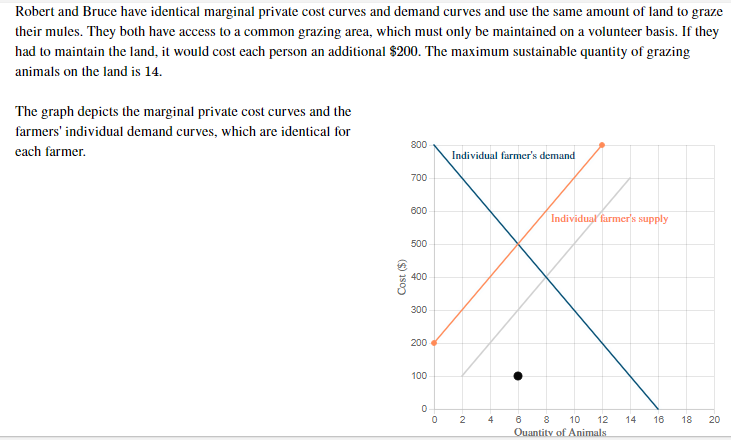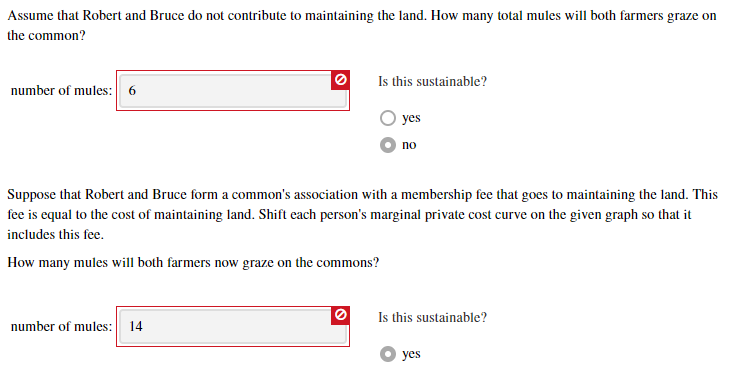Robert and Bruce have identical marginal private cost curves and demand curves and use the same amount of land to graze their mules. They both have access to a common grazing area, which must only be maintained on a volunteer basis. If they had to maintain the land, it would cost each person an additional $200. The maximum sustainable quantity of grazing animals on the land is 14. The graph depicts the marginal private cost curves and the farmers' individual demand curves, which are identical for 800 each farmer. Individual farmer's demand 700 600 Individual farmer's supply 500 400 300 200 100 10 12 14 16 18 20 Ouantity of Animals Cost ($) co Assume that Robert and Bruce do not contribute to maintaining the land. How many total mules will both farmers graze on the common? Is this sustainable? number of mules: 6 yes no Suppose that Robert and Bruce form a common's association with a membership fee that goes to maintaining the land. This fee is equal to the cost of maintaining land. Shift each person's marginal private cost curve on the given graph so that it includes this fee. How many mules will both farmers now graze on the commons? Is this sustainable? number of mules: 14 yes
Robert and Bruce have identical marginal private cost curves and demand curves and use the same amount of land to graze their mules. They both have access to a common grazing area, which must only be maintained on a volunteer basis. If they had to maintain the land, it would cost each person an additional $200. The maximum sustainable quantity of grazing animals on the land is 14. The graph depicts the marginal private cost curves and the farmers' individual demand curves, which are identical for 800 each farmer. Individual farmer's demand 700 600 Individual farmer's supply 500 400 300 200 100 10 12 14 16 18 20 Ouantity of Animals Cost ($) co Assume that Robert and Bruce do not contribute to maintaining the land. How many total mules will both farmers graze on the common? Is this sustainable? number of mules: 6 yes no Suppose that Robert and Bruce form a common's association with a membership fee that goes to maintaining the land. This fee is equal to the cost of maintaining land. Shift each person's marginal private cost curve on the given graph so that it includes this fee. How many mules will both farmers now graze on the commons? Is this sustainable? number of mules: 14 yes
Chapter14: Environmental Economics
Section: Chapter Questions
Problem 3SQ: From an economic viewpoint, the optimal amount of pollution a. is zero because all pollution imposes...
Related questions
Question

Transcribed Image Text:Robert and Bruce have identical marginal private cost curves and demand curves and use the same amount of land to graze
their mules. They both have access to a common grazing area, which must only be maintained on a volunteer basis. If they
had to maintain the land, it would cost each person an additional $200. The maximum sustainable quantity of grazing
animals on the land is 14.
The graph depicts the marginal private cost curves and the
farmers' individual demand curves, which are identical for
800
each farmer.
Individual farmer's demand
700
600
Individual farmer's supply
500
400
300
200
100
10
12
14
16
18
20
Ouantity of Animals
Cost ($)
co

Transcribed Image Text:Assume that Robert and Bruce do not contribute to maintaining the land. How many total mules will both farmers graze on
the common?
Is this sustainable?
number of mules:
6
yes
no
Suppose that Robert and Bruce form a common's association with a membership fee that goes to maintaining the land. This
fee is equal to the cost of maintaining land. Shift each person's marginal private cost curve on the given graph so that it
includes this fee.
How many mules will both farmers now graze on the commons?
Is this sustainable?
number of mules:
14
yes
Expert Solution
This question has been solved!
Explore an expertly crafted, step-by-step solution for a thorough understanding of key concepts.
This is a popular solution!
Trending now
This is a popular solution!
Step by step
Solved in 5 steps with 1 images

Recommended textbooks for you







Principles of Economics 2e
Economics
ISBN:
9781947172364
Author:
Steven A. Greenlaw; David Shapiro
Publisher:
OpenStax


Principles of Microeconomics
Economics
ISBN:
9781305156050
Author:
N. Gregory Mankiw
Publisher:
Cengage Learning